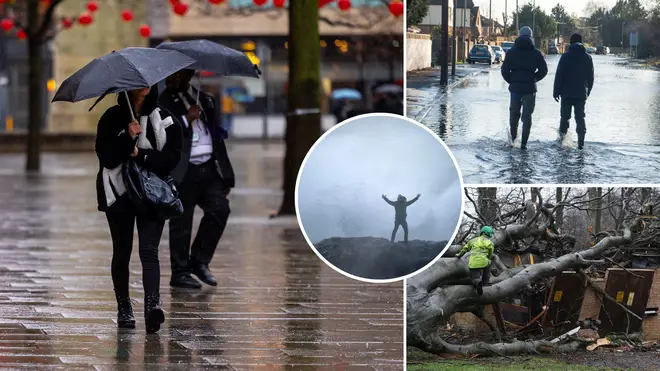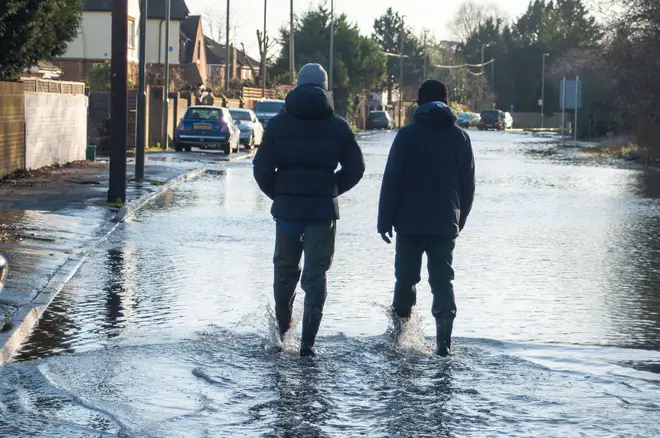
Nick Abbot 10pm - 1am
23 January 2024, 20:34 | Updated: 23 January 2024, 23:16

First came Storm Agnes. Storm Babet followed and then Storm Ciarán gripped the nation. Now, Storm Jocelyn has caused havoc.
In a typical autumn and winter, the UK experiences six to seven storms.
However this season the country has been pummelled by 10 storms, which have brought severe conditions, including but not limited to winds of up to 100mph and heavy rain resulting in major floods.
Read more: Sir Keir Starmer says Labour would ‘get ahead’ of torrential weather - as five killed by Storm Isha
Ever since the UK started naming storms, this is only the second time the letter J has been reached since 2015.
In 2015, the furthest Britain reached in naming a storm was Storm Kate.
However, even if the number of named storms this winter surpasses the total in 2015/16, it is difficult to accurately say if this season has been the most stormy.
The winter of 2013/14 was the wettest on record and was viewed as the stormiest for two decades.
However, storms were not named during this time, so comparing this year to years before 2015 would be an unclear process.
In addition, not every storm season has a named storm - there were none during the 2022/23 autumn and winter period until August 2023, when Storm Antoni and Barry were named.

Behind powerful storms are fast-moving winds - a jet stream - in the atmosphere which twists west to east across the Atlantic.
En route to the UK are areas of low pressure, with storm systems developing on the movement of the jet stream.
Jet streams are influenced by the contrast of temperatures between the Pile and mid-lattitudes and over the past few weeks, cold Arctic air has spread across the USA.
This leads to a massive temperature difference, therefore creating the conditions to create a powerful jet stream to generate storms.
Suzanne Gray, Professor of Meteorology at the University of Reading, says: "The number of storms that impact us each year can be influenced by meteorological phenomena occurring elsewhere across the globe such as the current El Niño event in the tropical Pacific region."
El Niño is associated with warmer-than-average sea surface temperatures in the Pacific, which may impact weather globally and usually brings wetter and windier weather in autumn and the start of winter to the UK, before a period of colder-than-average weather.
El Niño last appeared from 2014 to 2016, which was the last time the UK faced so many autumn and winter storms.

Storms are given a name when they are expected to reach an amber or red warning, issued by the Met Office National Severe Weather Warning Service.
Such warnings are issued when extreme weather conditions, such as heavy rain, wind and fog are forecasted.
Storms are named to ensure the public is more aware of incoming severe weather conditions.
The Met Office began naming storms after a survey revealed that people became more aware of extreme weather warnings once it was named.
In the 2023/24 season, Met Office suggestions include names of people who work to protect the public in times of severe weather, as well as submissions from the public.
There has been a total of 10 storms so far and have been named:
Even though these storms have yet to appear, there are already names for potential future storms this season:

Weather Journalist Nathan Rao joins Nick Ferrari on Storm Henk
The missing letters are to be consistent with "official storm naming in the North Atlantic".
According to AccuWeather’s senior meteorologist, Dan Pydynowski, other parts of the world do use some of these letters when naming their tropical storms or cyclones.
He explained: "The East Pacific uses X, Y and Z, while the Atlantic does not… the East Pacific averages more named storms per year. Thus, more names are needed in an average year and there is a better chance [of reaching] the end of the list."
Forecasts for the first week of February suggest the weather will be more settled, so reaching Storm Kathleen looks unlikely.
It is hard to accurately tell the forecasts after the first week, but February looks to be calmer throughout, with average temperatures.
Read more: Exact date storms to end as Met Office predicts return of sunshine and warmer weather
Although, there are some signs that the weather will turn colder.